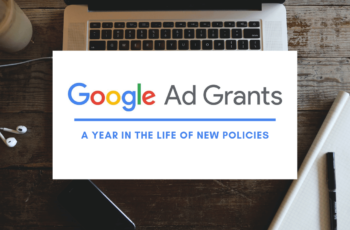Google Ad Grants FAQs
When nonprofits first get started with the Google Ad Grant and the Google Ads platform, there are some common questions advertisers have before getting started. We’ve compiled a list of frequently asked questions to help you get started with digital marketing.
-
If I don’t spend all of my Grant money, will I lose it?
The Google Ad Grant is an in-kind grant, meaning it offers up to $10,000 in ad spend each month. However, if advertisers do not spend all of the ad spend credits in a month, the $10,000 starts over again the next month. As long as a nonprofit is in compliance with Google Ads for Nonprofits, they will never have to reapply for the grant.
-
Can I use multiple domains with my Google Ad Grant account?
Multiple domains can be submitted for approval within a single Google Ads account if they meet the website policy established by Google Ad Grants. If the site meets the requirements the advertiser can submit a request for an additional domain and expect to hear back about approval within a week.
-
Can I get more social media followers with Google Ads?
Although you cannot create ads directly linking to your social media pages, you can link users viewing your ads to your organization’s social media accounts by adding sitelink extensions that link directly to the page. These sitelink extensions typically go well with ads for brand awareness or in ad groups with brand name keywords.
-
What are my industry benchmarks for performance?
All nonprofit organizations must maintain a click-through rate (CTR) of at least 5%, but the standard for each metric lies within the nonprofit industry. The comparable benchmarks for each nonprofit will depend on the industry it is classified under.
-
Can you track donations received from the Google Ad Grant?
Yes, you can track donations from the Google Ad Grant. You have to have ecommerce tracking which is simple to enable through donation platforms such as Classy or Blackbaud. There are a number of donation platforms in which e-commerce integration is not part of their functionality such as Paypal. However, using Google Tag Manager you can still track outbound clicks to donate. While it doesn’t track the specific donation, it does track the users’ intent to give.
-
What are the best donation portals? (or) What donation portals are easy to integrate with Google Analytics/Google Ads?
Blackbaud, Classy, Woocommerce all have simple integration with Google Analytics.
-
How should I set up tracking my new micro-site or domain?
You would use the same Analytics as your main domain and then you can integrate Cross-Domain tracking through Google Tag Manager.
-
What’s the best way to come up with new content ideas that will be trendy? How do we find trendy blog ideas?
An easy way to start thinking of blog topics is to think about the season. Upcoming holidays, spring cleaning, and summer heat safety are all popular topics that repeat every year. When considering what content to put on your site, it should have a long-term purpose to answer a question before directing the reader to the next step in the marketing funnel.
-
Did someone who clicked to donate actually donate?
If your donation platform is offsite, the data tracking code we use is no longer able to track the user. Once the user clicks the button that leads to another domain, whether it be a ‘Donate,’ ‘Download,’ or other, we are no longer able to monitor a user’s actions because you can only put tracking on sites you own. When you compare the amount of people that clicked to donate to your actual processed donations, you can better understand your conversion rate. This also highlights the steps of the marketing funnel that traffic drops off at so you know what to improve upon for better performance.
-
What does it mean that impressions are down but CTR has increased?
When impressions decrease and the CTR increases in Google Ads, it is a likely indication that your audience targeting has been refined to a more precise point.
-
So I should put my donation call to action on the bottom of the blog post?
The main call to action (CTA) for your piece of content on a landing page should be at the bottom of the page, but there should also be smaller, soft CTAs sprinkled throughout the blog. This can be done by breaking up the content with buttons or with internal hyperlinking. Getting users to click on a call to action brings them a step closer to a desirable conversion or action, which should be the main point of all blogs in the end.
-
Can we increase the budget for my campaign?
To equal a total of $10,000 in ad spend every month, Google Ad Grant accounts can spend up to $329 within the account each day. In order to increase the budget of one campaign, ad spend potential must be taken out of another campaign.















